|
| |
|
The technicolor photography is stunning, lush and beautiful. The
music, with strains of "Claire de Lune," is enchanting, like the creek, and
the very romantic adventure story.
The film is a faithful adaptation of the 1941 novel except
for the parts involving Dona's adultery with the pirate. The film censors of the 1940s would have none
of that. The screenplay was only to suggest a sexual longing, but no
fulfillment. Some of the dialogue is lifted directly out of the novel.
The film was completed in the fall of 1943, but wasn't
released to theatres until September 1944.
All of the actors played their roles to
perfection. The characters appear to have jumped right from the pages of
the novel. Rathbone was perfect as the lecherous Lord Rockingham; I cannot
imagine anyone else playing that role. Rathbone was under contract to MGM
at the time, but Paramount "borrowed" him to play the role of Rockingham.
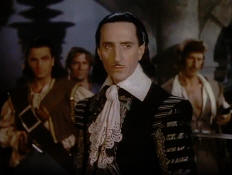
Rock sees the way Dona looks at the pirate and suspects they are
lovers. |
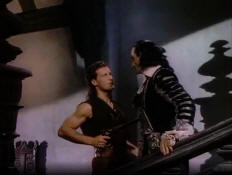
One of the pirates forces Rock to an upstairs room. |
Joan Fontaine allegedly claimed that the success of
Frenchman's Creek was a burden on her shoulders alone. Her co-players
didn't appreciate this insult.
The insult caused tension between Fontaine and her fellow actors
in the film.
Frenchman's Creek won an Academy Award for art direction and set design.
Frenchman's Creek was remade as a television movie in 1998.
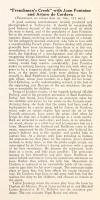 "Frenchman's Creek" with Joan Fontaine and
Arturo de Cordova "Frenchman's Creek" with Joan Fontaine and
Arturo de CordovaA good costume entertainment, lavishly
produced and photographed in Technicolor. It should do exceptionally
good business because of the widely-read novel on which the story is
based, and of the popularity of Joan Fontaine. Set in the
seventeenth century, the story is an adventurous romantic drama
revolving around the escapades of a beautiful but unhappily married
aristocrat, who falls in love with a swashbuckling French pirate.
Pictures dealing with pirates generally have more excitement than
there is in this one, nevertheless, it has a fair quota of thrills,
including sword duels, the hijacking of a merchantman, and all the
other swaggering doings identified with pictures of this type. It
does, however, have many slow spots, and some judicious cutting
would help matters considerably. Joan Fontaine makes an enticing
heroine, enacting her role with what appears to be a tongue-in-cheek
exuberance. Arturo de Cordova, as the pirate chief, looks more
dashing than he actually is. Basil Rathbone is ludicrously leering
as the foppish villain, whom Joan murders in a fight for her honor.
Cecil Kellaway, as the understanding servant, is the best of the
supporting cast. Because of the sex situations, the picture is
unsuitable for children:—
Tiring of London society, of her foppish husband (Ralph Forbes),
and of the persistent attentions of Basil Rathbone, Forbes' best
friend, Joan Fontaine, an aristocrat, takes her two children and
leaves for her estate on the Cornish coast. Arriving there, she
finds that the estate had been used as headquarters by a pirate
gang, led by Arturo de Cordova, whose raids on estates nearby had
raised the ire of the Cornish aristocrats. Joan meets the pirate
chief when he brings his ship into a hidden anchorage in a creek
nearby. Both are attracted to each other, and Joan, in an
adventurous mood, dresses as a cabin boy and accompanies him on a
foray. Meanwhile her husband and Rathbone come to the estate,
summoned by the Cornish gentry, who believed the pirate's hideout
was in the vicinity, and needed help to capture him. At a dinner,
with Joan presiding as hostess, the aristocrats lay their plans for
the capture. Joan's shrewd methods to delay them, so that the pirate
might escape, are interrupted by de Cordova's daring entrance with a
group of his best swordsmen. He disarms the aristocrats, locks them
in a room, and bids Joan goodbye. The aristocrats manage to free
themselves and give chase. Rathbone remains behind and tries to
force his unwelcome attentions on Joan. Rather than submit, she
kills him. Meanwhile de Cordova is captured as he successfully holds
off the aristocrats to gain time for his crew's escape. The
aristocrats make plans to hang him, but Joan effects his escape
through a ruse. De Cordova begs Joan to sail away with him, but she
realizes her duty to her children, and chooses to remain at the
estate.
Talbot Jennings wrote the screen play from the book by Daphne du
Maurier, David Lewis produced it, and Mitchell Leisen directed it.
B.G. DeSylva was the executive producer. The cast includes Nigel
Bruce and others.
—Harrison's Reports, September 23, 1944 |
Variety reported that the film cost more than three
million dollars to produce. In spite of the high production cost, Frenchman's
Creek was a
commercial success, at least in the big cities. The Film Daily (Sept. 22, 1944) reported that
Frenchman's Creek broke all opening day records
at the Rivoli in New York City. The first week exceeded previous records by $10,000. (The Film
Daily, Sept. 29, 1944).
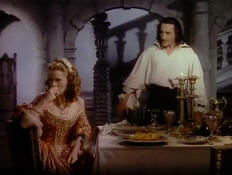 |
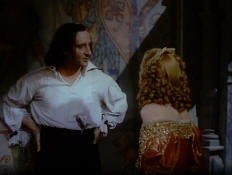 |
Comments from small-town theatre owners:
"The most spectacular and colorful flop of the season."
—Rudolph Covi, Covi
Theatre,
Herminie, PA (Box Office, June 23, 1945)
"It is amazing how much money is squandered on trite screen material; the
production on this alone must have reached well into the millions. The
finished picture is not down the ally of small towns and I doubt if the
rank and file patron is going to get excited about it. I heard some
complaints about its length. ... Personally, I liked Mr. Rathbone better
than anything else in the picture. He did full justice to his villainous
role."
—Thomas di Lorenzo, New Paltz Theatre, New Paltz, NY (Motion Picture
Herald, February 17, 1945)
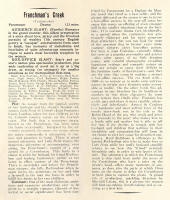 Frenchman's Creek Frenchman's CreekAUDIENCE SLANT:
(Family) Romance in the grand manner, this silken presentation of a
story about love, piracy and the frivolous pursuits of wealthy 17th
century English gentry is "escapist" entertainment from start to
finish; has moments of melodrama and interludes of quite adventurous
romantic intrigue to assure most favorable receptions by the women.
BOX-OFFICE SLANT: Star's and costar's names plus
spectacular production, plus wide readership of novel set it up as a
big draw, as strong (or stronger) for smaller situations as for
metropolitan first-runs.
Plot: As escape from the foppish society of her husband
and his friend's insolent advances, Lady Dona St. Columb (Joan
Fontaine) leaves London, takes her two children to the St. Columb
country estate on the Cornish coast. She finds that a notorious
pirate, known as the Frenchman, has been using the home
occasionally. Intrigued by the adventure promised, she meets the
pirate, whom the entire countryside is attempting to capture and
promises to hang. There is great mutual attraction, and Lady Dona
essays the dangerous adventure of accompanying, even aiding, the
Frenchman's capture of a ship owned by a Cornishman. This leads to a
climax in which her husband, his friend Rockingham and leading
landowners gather at her home to effect capture of the Frenchman.
There is swordplay and before the Frenchman escapes, she kills
Rockingham when he again forces his attentions on her and bids a
farewell to the man she loves in order to fulfill her duties to her
two children.
Comment: One of the most elaborate, ambitious and
expensive productions ever to be given to a straight romance (devoid
of historical or social significance) has been contrived by
Paramount for a Daphne du Maurier novel that rated as a best-seller,
and the picture delivered on the screen is one to prove a box-office
success in the over-all sense because this seems an offering of even
stronger pull in the smaller situations than at the first-runs. It
is costume drama (set, incidentally, in a period when the costumery
was grotesquely elaborate and far more gorgeous than attractive),
but you can look for none of the aversion that in former years made
costume pictures sheer box-office poison. For here is Joan Fontaine—currently riding the crest as a
popular personality and actress—plus other names of no little
drawing power, with colorful photography revealing beauteous
settings and romantic goings on that are certain to cause sheer
delight in the feminine ranks of theatregoers—and they are the ones that count
in making a picture a box-office success. The era dealt with—1668—is so remote as to make even
extravagances in certain story elements quite acceptable as reality.
On the other hand, this advantage in one direction has its handicap
in another, in that these characters do seem more remote than
vitally alive. Fontaine has a rich part and plays it most capably,
attractively and infectiously. Arturo de Cordova is a handsome and
most gallant lover of the purely story-book sort in his role as the
Robin Hood of the sea, who steals and gives the proceeds to the
poor; who makes love to a lovely wife and mother but is able to tell
her that if she decides to remain with her husband and children that
nothing in their friendship and companionship will loom in the
future to give her cause for disturbed conscience. Basil Rathbone is
villainous as the hateful Rockingham who tries to make love to Lady
Dona while her stuffy husband stupidly refuses to see how this
"friend" pretends friendship only in order to win favors of his
wife. The adventure in which the Frenchman steals a ship right from
under the noses of the Cornishmen who have a price on the pirate's
head—offers many moments of suspense,
as does also the party at which Dona turns on the charm to delay the
Cornishmen in their plan to capture the pirate. A grand job of
production, sparkling direction by Mitchell Leisen, this is a
picture the women will find eye-taking, breath-taking and as
exciting as a first kiss.
—Showmen's Trade Review,
September 23, 1944 |
"Frenchman's Creek brims over with flashing swordplay."
—John Lardner,
The New Yorker, Sept. 30, 1944
"Basil Rathbone sneers darkly and lupinely as the suitor who gets
it in the neck."
—Bosley Crowther, New York Times, September 21,
1944
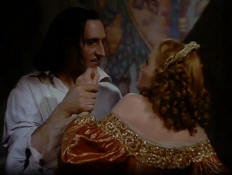
Rockingham accuses Dona of loving the pirate. |
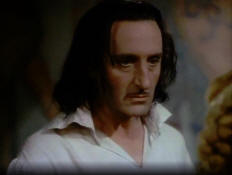
"If you hadn't left London, it would have been me [you made
love to]!" |
"Basil Rathbone manages some capital moments."
—Hollywood Reporter
 "Frenchman's Creek" "Frenchman's Creek"To get going with
"Frenchman's Creek" by remarking it is out of this world is to get
going with a very literal remark. The place is England, the time is
the 17th century, and its piratical events have nothing at all to do
with the kind of events currently under way in Western Europe and
the Pacific. escapism is not only the key, it is the whole
structure. In these days of widespread reaction against pictures
concerning war, the point can be highly important. Probably is, too.
There are others. This attraction, made with an open pocketbook
by producer David Lewis and director Mitchell Leisen, is compounded
from a best-seller by Daphne du Maurier. It is also the first pirate
picture since Tyrone Power swaggered his way through "The Black
Swan" two years ago. By that approach, strong values not available
to ticket buyers from any other current direction are suggested.
Plus-value on its ledger is an excellent performance by Joan
Fontaine who registers so beautifully in color that she might well
be regarded as one of Hollywood's luminaries fro whom this process
could have been conceived. As the lady with an urge, she
out-distances the rest of the cast by a seven-league boot or so. As
the manly one who recognizes both a lady and an urge, Arturo de
Cordova cuts a dashing and romantic figure and makes understandable
why Miss Fontaine almost succumbs to the salt, the wind, the spray,
etc. But not quite. In fact, there is considerable of that urge
business around. from the outset, Miss Fontaine, whose fictional
name is as fancy as Dona St. Columb, is hankering for the romance
which her husband, Harry, does not provide. When she leaves London
for their Cornish home and shortly thereafter meets de Cordova, a
Robin-Hood type of high seas marauder, she becomes quite a willing
wanderer from hearth, home and children. Where Harry is blundering
and boorish, Jean Benoit Aubrey—that's de Cordova—is courtly, dashing, romantic. In
short, he's French.
And so it is, they fall madly in
love. The heroine accompanies her pirate-hero on an expedition. She
protects his interests, meaning his safety, when the squires of the
county band together to remove him from the scene. She kills Lord
Rockingham—that's Basil Rathbone—when he tries to throttle her. She
arranges her hero's escape Finally, decision time arrives. It finds
her resisting piracy, high seas and the wind through the sails to
stand by the obligation which her children represent. In-between,
she has indulged in much gallivanting around the countryside, but
the dialogue makes it crystal-clear she has done nothing of which
she need be ashamed.
"Frenchman's Creek" is a decided
showpiece, a sort of concerto on celluloid. Its production
investiture is magnificent. Its photography, at the hands of George
Barnes, is arresting. Its settings are big. Its seascapes and its
shipscapes—to coin a word—are lovely in sweep and
composition. Nothing was spared to fill the eyes, and keep them that
way.
Dramatically, the enterprise doesn't
match. Those doublets, wigs and trappings which are 17th century get
in the way of story and characters, a common result in this type is
idyllized romantic drama. What comedy is around lumbers and creaks
and the attraction would move faster toward its goal in less
footage. Incidents are contrived for convenience, not for
believability.
Nevertheless, it's a show. In point
of scale, it's a big show. In point of offering a different kind of
romance, lacking competition at this juncture, there is advantage.
If make-believe of a far-off day in a tapestry of long, long ago and
a pirate yarn are big box-office, this attraction, which makes its
bow at the Rivoli, New York Wednesday morning, is it. Other
principals in the cast are Ralph Forbes, Nigel Bruce and Cecil
Kellaway.
Red Kann
—Motion Picture Daily, September 20, 1944 |
"A monument of camp ... an orgy of Technicolor
sadomasochism—worthy of Hammer or a Roger Corman film of Poe."
—David Melville,
Senses of Cinema, October 2005
"Rathbone ... was excellent as Lord Rockingham. The scene
in which he confronts Dona is definitely the most effective moment in the
picture."
| |















